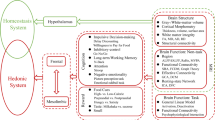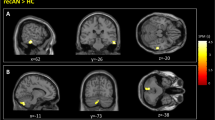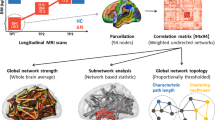Abstract
Background
Obesity is a disease that may involve disrupted connectivity of brain networks. Bariatric surgery is an effective treatment for obesity, and the positive effects on obesity-related conditions may be enhanced by exercise. Herein, we aimed to investigate the possible synergistic effects of Roux-en-Y Gastric Bypass (RYGB) and exercise training on brain functional networks.
Methods
Thirty women eligible for bariatric surgery were randomly assigned to a Roux-en-Y gastric bypass (RYGB: n = 15, age = 41.0 ± 7.3 years) or RYGB plus Exercise Training (RYGB + ET: n = 15, age = 41.9 ± 7.2 years). Clinical, laboratory, and brain functional connectivity parameters were assessed at baseline, and 3 (POST3) and 9 months (POST9) after surgery. The 6-month, three-times-a-week, exercise intervention (resistance plus aerobic exercise) was initiated 3 months post-surgery (for RYGB + ET).
Results
Exercise superimposed on bariatric surgery (RYGB + ET) increased connectivity between hypothalamus and sensorial regions (seed-to-voxel analyses of hypothalamic connectivity), and decreased default mode network (DMN) and posterior salience (pSAL) network connectivity (ROI-to-ROI analyses of brain networks connectivity) when compared to RYGB alone (all p-FDR < 0.05). Increases in basal ganglia (BG) network connectivity were only observed in the exercised training group (within-group analyses).
Conclusion
Exercise training is an important component in the management of post-bariatric patients and may improve the hypothalamic connectivity and brain functional networks that are involved in controlling food intake.
Trial registration
Clinicaltrial.gov: NCT02441361.
This is a preview of subscription content, access via your institution
Access options
Subscribe to this journal
Receive 12 print issues and online access
$259.00 per year
only $21.58 per issue
Buy this article
- Purchase on Springer Link
- Instant access to full article PDF
Prices may be subject to local taxes which are calculated during checkout





Similar content being viewed by others
Data availability
The data that support the findings of this study are available from the corresponding author, BG, upon reasonable request.
References
Hossain P, Kawar B, El Nahas M. Obesity and diabetes in the developing world–a growing challenge. N Engl J Med. 2007;356:213–5.
Shefer G, Marcus Y, Stern N. Is obesity a brain disease? Neurosci Biobehav Rev. 2013;37:2489–503.
Deco G, Jirsa VK, McIntosh AR. Emerging concepts for the dynamical organization of resting-state activity in the brain. Nat Rev Neurosci. 2011;12:43–56.
Syan SK, McIntyre-Wood C, Minuzzi L, Hall G, McCabe RE, MacKillop J. Dysregulated resting state functional connectivity and obesity: a systematic review. Neurosci Biobehav Rev. 2021;131:270–92.
Donofry SD, Stillman CM, Erickson KI. A review of the relationship between eating behavior, obesity and functional brain network organization. Soc Cogn Affect Neurosci. 2020;15:1157–81.
NIH conference. Gastrointestinal surgery for severe obesity. Consensus Development Conference Panel. Ann Intern Med. 1991;115:956–61.
Ashrafian H, le Roux CW, Darzi A, Athanasiou T. Effects of bariatric surgery on cardiovascular function. Circulation. 2008;118:2091–102.
Kirwan JP, Courcoulas AP, Cummings DE, Goldfine AB, Kashyap SR, Simonson DC, et al. Diabetes remission in the alliance of randomized trials of medicine versus metabolic surgery in type 2 diabetes (ARMMS-T2D). Diabetes Care. 2022;45:1574–83.
van de Sande-Lee S, Pereira FR, Cintra DE, Fernandes PT, Cardoso AR, Garlipp CR, et al. Partial reversibility of hypothalamic dysfunction and changes in brain activity after body mass reduction in obese subjects. Diabetes. 2011;60:1699–704.
Schauer PR, Bhatt DL, Kirwan JP, Wolski K, Aminian A, Brethauer SA, et al. Bariatric surgery versus intensive medical therapy for diabetes—5-year outcomes. N Engl J Med. 2017;376:641–51.
Olivo G, Zhou W, Sundbom M, Zhukovsky C, Hogenkamp P, Nikontovic L, et al. Resting-state brain connectivity changes in obese women after Roux-en-Y gastric bypass surgery: a longitudinal study. Sci Rep. 2017;7:6616.
Salem V, Demetriou L, Behary P, Alexiadou K, Scholtz S, Tharakan G, et al. Weight loss by low-calorie diet versus gastric bypass surgery in people with diabetes results in divergent brain activation patterns: a functional MRI study. Diabetes Care. 2021;44:1842–51.
Dantas WS, Gil S, Murai IH, Costa-Hong V, Pecanha T, Merege-Filho CAA, et al. Reversal of improved endothelial function after bariatric surgery is mitigated by exercise training. J Am Coll Cardiol. 2018;72:2278–9.
Dantas WS, Roschel H, Murai IH, Gil S, Davuluri G, Axelrod CL, et al. Exercise-induced increases in insulin sensitivity after bariatric surgery are mediated by muscle extracellular matrix remodeling. Diabetes. 2020;69:1675–91.
Gil S, Pecanha T, Dantas WS, Murai IH, Merege-Filho CAA, de Sa-Pinto AL, et al. Exercise enhances the effect of bariatric surgery in markers of cardiac autonomic function. Obes Surg. 2020;31:1381–6.
Coen PM, Menshikova EV, Distefano G, Zheng D, Tanner CJ, Standley RA, et al. Exercise and weight loss improve muscle mitochondrial respiration, lipid partitioning, and insulin sensitivity after gastric bypass surgery. Diabetes. 2015;64:3737–50.
Coen PM, Tanner CJ, Helbling NL, Dubis GS, Hames KC, Xie H, et al. Clinical trial demonstrates exercise following bariatric surgery improves insulin sensitivity. J Clin Investig. 2015;125:248–57.
Gil S, Kirwan JP, Murai IH, Dantas WS, Merege-Filho CAA, Ghosh S, et al. A randomized clinical trial on the effects of exercise on muscle remodelling following bariatric surgery. J Cachexia, Sarcopenia Muscle. 2021;12:1440–55.
Murai IH, Roschel H, Dantas WS, Gil S, Merege-Filho C, de Cleva R, et al. Exercise mitigates bone loss in women with severe obesity after roux-en-y gastric bypass: a randomized controlled trial. J Clin Endocrinol Metab. 2019;104:4639–50.
Hillman CH, Erickson KI, Kramer AF. Be smart, exercise your heart: exercise effects on brain and cognition. Nat Rev Neurosci. 2008;9:58–65.
Won J, Callow DD, Pena GS, Gogniat MA, Kommula Y, Arnold-Nedimala NA, et al. Evidence for exercise-related plasticity in functional and structural neural network connectivity. Neurosci Biobehav Rev. 2021;131:923–40.
Evero N, Hackett LC, Clark RD, Phelan S, Hagobian TA. Aerobic exercise reduces neuronal responses in food reward brain regions. J Appl Physiol. 2012;112:1612–9.
McFadden KL, Cornier MA, Melanson EL, Bechtell JL, Tregellas JR. Effects of exercise on resting-state default mode and salience network activity in overweight/obese adults. Neuroreport. 2013;24:866–71.
Friedewald WT, Levy RI, Fredrickson DS. Estimation of the concentration of low-density lipoprotein cholesterol in plasma, without use of the preparative ultracentrifuge. Clin Chem. 1972;18:499–502.
Muschelli J, Nebel MB, Caffo BS, Barber AD, Pekar JJ, Mostofsky SH. Reduction of motion-related artifacts in resting state fMRI using aCompCor. Neuroimage. 2014;96:22–35.
Whitfield-Gabrieli S, Nieto-Castanon A. Conn: a functional connectivity toolbox for correlated and anticorrelated brain networks. Brain Connect. 2012;2:125–41.
Baroncini M, Jissendi P, Balland E, Besson P, Pruvo JP, Francke JP, et al. MRI atlas of the human hypothalamus. Neuroimage. 2012;59:168–80.
Ding Y, Ji G, Li G, Zhang W, Hu Y, Liu L, et al. Altered interactions among resting-state networks in individuals with obesity. Obesity. 2020;28:601–8.
Prehn K, Lesemann A, Krey G, Witte AV, Kobe T, Grittner U, et al. Using resting-state fMRI to assess the effect of aerobic exercise on functional connectivity of the DLPFC in older overweight adults. Brain Cognition. 2019;131:34–44.
Shirer WR, Ryali S, Rykhlevskaia E, Menon V, Greicius MD. Decoding subject-driven cognitive states with whole-brain connectivity patterns. Cereb Cortex. 2012;22:158–65.
Morton GJ, Cummings DE, Baskin DG, Barsh GS, Schwartz MW. Central nervous system control of food intake and body weight. Nature. 2006;443:289–95.
Kerem L, Holsen L, Fazeli P, Bredella MA, Mancuso C, Resulaj M, et al. Modulation of neural fMRI responses to visual food cues by overeating and fasting interventions: a preliminary study. Physiol Rep. 2021;8:e14639.
Kullmann S, Pape AA, Heni M, Ketterer C, Schick F, Haring HU, et al. Functional network connectivity underlying food processing: disturbed salience and visual processing in overweight and obese adults. Cereb Cortex. 2013;23:1247–56.
Cavalcanti-de-Albuquerque JP, Donato J Jr. Rolling out physical exercise and energy homeostasis: focus on hypothalamic circuitries. Front Neuroendocrinol. 2021;63:100944.
Ibeas K, Herrero L, Mera P, Serra D. Hypothalamus-skeletal muscle crosstalk during exercise and its role in metabolism modulation. Biochem Pharmacol. 2021;190:114640.
Tregellas JR, Wylie KP, Rojas DC, Tanabe J, Martin J, Kronberg E, et al. Altered default network activity in obesity. Obesity. 2011;19:2316–21.
Heinrichs HS, Beyer F, Medawar E, Prehn K, Ordemann J, Floel A, et al. Effects of bariatric surgery on functional connectivity of the reward and default mode network: a pre-registered analysis. Hum Brain Mapp. 2021;42:5357–73.
Seeley WW, Menon V, Schatzberg AF, Keller J, Glover GH, Kenna H, et al. Dissociable intrinsic connectivity networks for salience processing and executive control. J Neurosci. 2007;27:2349–56.
Garcia-Garcia I, Jurado MA, Garolera M, Segura B, Sala-Llonch R, Marques-Iturria I, et al. Alterations of the salience network in obesity: a resting-state fMRI study. Hum Brain Mapp. 2013;34:2786–97.
Sewaybricker LE, Melhorn SJ, Askren MK, Webb MF, Tyagi V, De Leon MRB, et al. Salience network connectivity is reduced by a meal and influenced by genetic background and hypothalamic gliosis. Int J Obes. 2020;44:167–77.
DelParigi A, Chen K, Salbe AD, Hill JO, Wing RR, Reiman EM, et al. Successful dieters have increased neural activity in cortical areas involved in the control of behavior. Int J Obes. 2007;31:440–8.
Tan Z, Hu Y, Ji G, Li G, Ding Y, Zhang W, et al. Alterations in functional and structural connectivity of basal ganglia network in patients with obesity. Brain Topogr. 2022;35:453–63.
Gualano B, Kirwan JP, Roschel H. Exercise is key to sustaining metabolic gains after bariatric surgery. Exerc Sport Sci Rev. 2021;49:197–204.
Funding
The authors acknowledge the support by Sao Paulo Research Foundation (FAPESP - 2016/10993-5), the Brazilian National Council for Scientific and Technological Development (CNPq - grant 400157/2016-0 and 301571/2017-1). The study is also partially supported by NIGMS U54GM104940, and NIGMS P20GM103528 from NIH, USA.
Author information
Authors and Affiliations
Contributions
CAAMF, IHM, HR, WSD, SG, RC, MAS, and BG contributed to the study concept and design. All authors contributed to acquisition, analysis, or interpretation of data, and critically reviewed the manuscript for important intellectual content. CAAMF, HR, SG, MPN, and BG drafted the manuscript and conducted the statistical analysis. HR, JPK, and BG obtained funding for the study. RC, ALP, FL, MAS, CCL MCGO, and RMRP provided administrative, technical, or material support. MCGO, HR, and BG supervised the study. CAAMF and BG had full access to all of the data in the study and take responsibility for the integrity of the data and the accuracy of the data analysis.
Corresponding author
Ethics declarations
Competing interests
The authors declare no competing interests.
Additional information
Publisher’s note Springer Nature remains neutral with regard to jurisdictional claims in published maps and institutional affiliations.
In memorian: Rosa M. R. Pereira.
Supplementary information
Rights and permissions
Springer Nature or its licensor (e.g. a society or other partner) holds exclusive rights to this article under a publishing agreement with the author(s) or other rightsholder(s); author self-archiving of the accepted manuscript version of this article is solely governed by the terms of such publishing agreement and applicable law.
About this article
Cite this article
Merege-Filho, C.A.A., Gil, S.S., Kirwan, J.P. et al. Exercise modifies hypothalamic connectivity and brain functional networks in women after bariatric surgery: a randomized clinical trial. Int J Obes 47, 165–174 (2023). https://doi.org/10.1038/s41366-022-01251-8
Received:
Revised:
Accepted:
Published:
Issue Date:
DOI: https://doi.org/10.1038/s41366-022-01251-8



